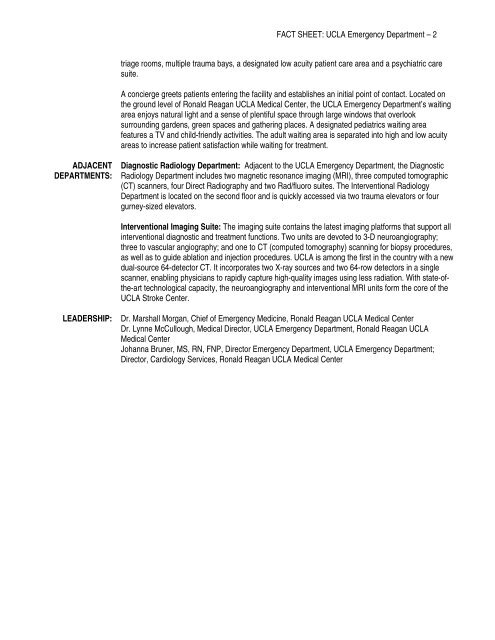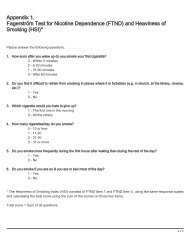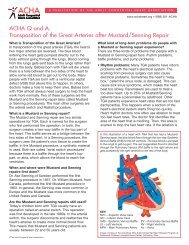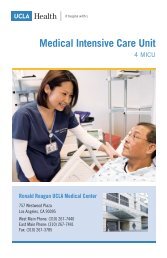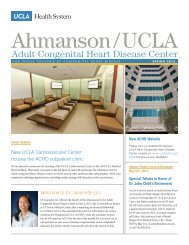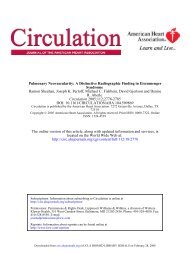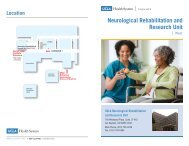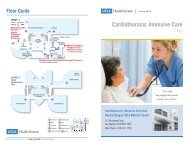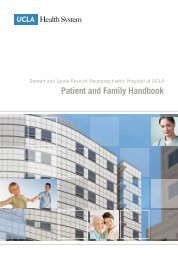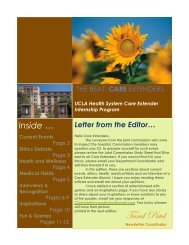FACT SHEET Ronald Reagan UCLA Medical Center David I ...
FACT SHEET Ronald Reagan UCLA Medical Center David I ...
FACT SHEET Ronald Reagan UCLA Medical Center David I ...
You also want an ePaper? Increase the reach of your titles
YUMPU automatically turns print PDFs into web optimized ePapers that Google loves.
<strong>FACT</strong> <strong>SHEET</strong>: <strong>UCLA</strong> Emergency Department – 2<br />
triage rooms, multiple trauma bays, a designated low acuity patient care area and a psychiatric care<br />
suite.<br />
A concierge greets patients entering the facility and establishes an initial point of contact. Located on<br />
the ground level of <strong>Ronald</strong> <strong>Reagan</strong> <strong>UCLA</strong> <strong>Medical</strong> <strong>Center</strong>, the <strong>UCLA</strong> Emergency Department’s waiting<br />
area enjoys natural light and a sense of plentiful space through large windows that overlook<br />
surrounding gardens, green spaces and gathering places. A designated pediatrics waiting area<br />
features a TV and child-friendly activities. The adult waiting area is separated into high and low acuity<br />
areas to increase patient satisfaction while waiting for treatment.<br />
ADJACENT<br />
DEPARTMENTS:<br />
Diagnostic Radiology Department: Adjacent to the <strong>UCLA</strong> Emergency Department, the Diagnostic<br />
Radiology Department includes two magnetic resonance imaging (MRI), three computed tomographic<br />
(CT) scanners, four Direct Radiography and two Rad/fluoro suites. The Interventional Radiology<br />
Department is located on the second floor and is quickly accessed via two trauma elevators or four<br />
gurney-sized elevators.<br />
Interventional Imaging Suite: The imaging suite contains the latest imaging platforms that support all<br />
interventional diagnostic and treatment functions. Two units are devoted to 3-D neuroangiography;<br />
three to vascular angiography; and one to CT (computed tomography) scanning for biopsy procedures,<br />
as well as to guide ablation and injection procedures. <strong>UCLA</strong> is among the first in the country with a new<br />
dual-source 64-detector CT. It incorporates two X-ray sources and two 64-row detectors in a single<br />
scanner, enabling physicians to rapidly capture high-quality images using less radiation. With state-ofthe-art<br />
technological capacity, the neuroangiography and interventional MRI units form the core of the<br />
<strong>UCLA</strong> Stroke <strong>Center</strong>.<br />
LEADERSHIP:<br />
Dr. Marshall Morgan, Chief of Emergency Medicine, <strong>Ronald</strong> <strong>Reagan</strong> <strong>UCLA</strong> <strong>Medical</strong> <strong>Center</strong><br />
Dr. Lynne McCullough, <strong>Medical</strong> Director, <strong>UCLA</strong> Emergency Department, <strong>Ronald</strong> <strong>Reagan</strong> <strong>UCLA</strong><br />
<strong>Medical</strong> <strong>Center</strong><br />
Johanna Bruner, MS, RN, FNP, Director Emergency Department, <strong>UCLA</strong> Emergency Department;<br />
Director, Cardiology Services, <strong>Ronald</strong> <strong>Reagan</strong> <strong>UCLA</strong> <strong>Medical</strong> <strong>Center</strong>


